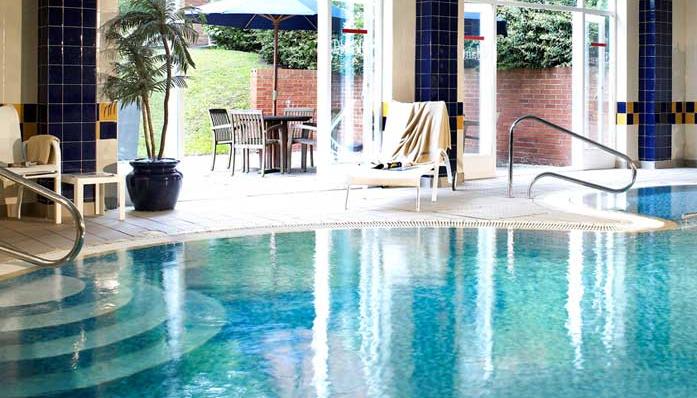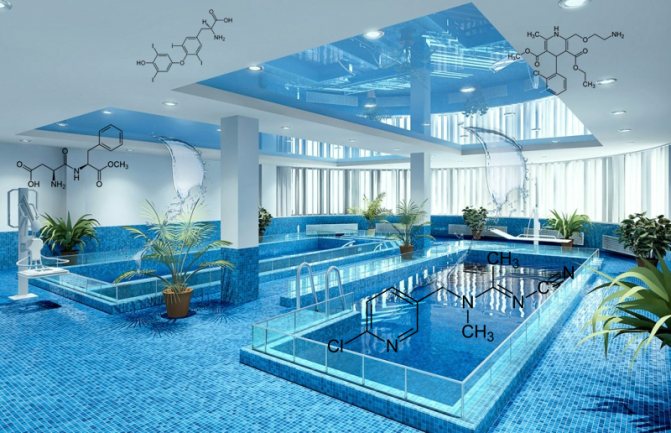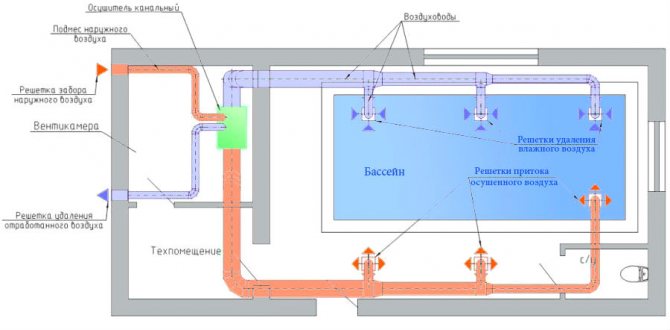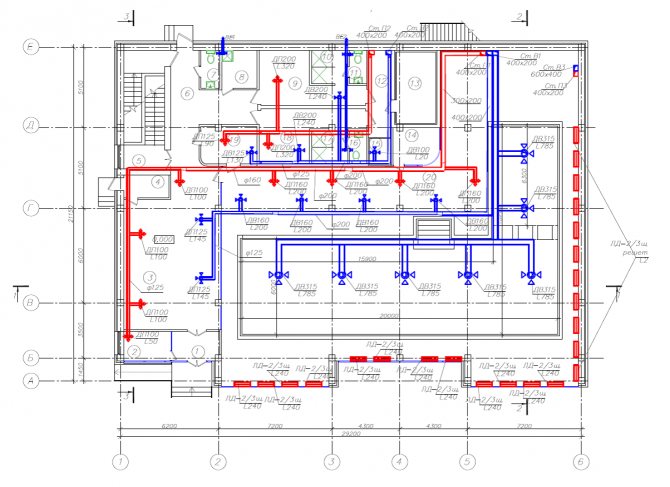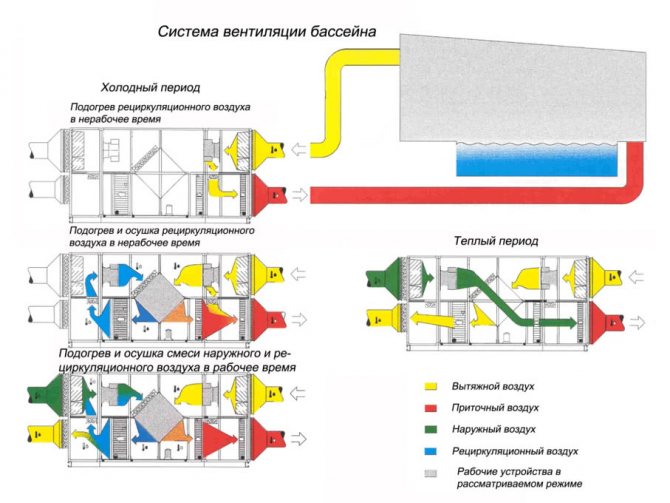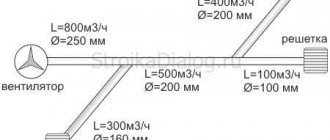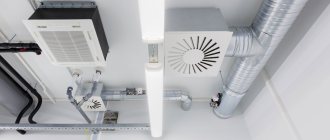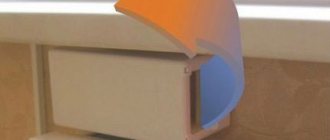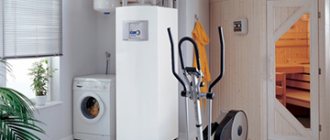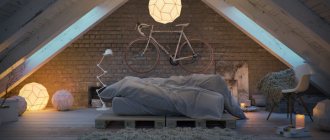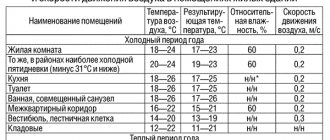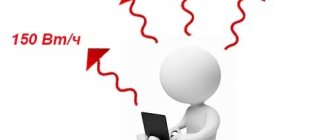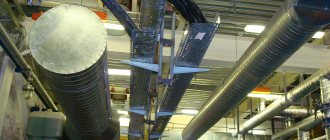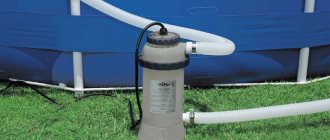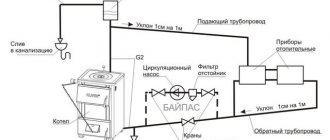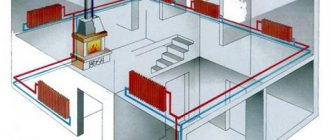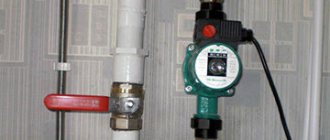When do you need a ventilation system in the pool?
Pool ventilation solves 3 problems: it supplies air for breathing, removes moisture and odors. A dehumidifier only removes moisture, and the air remains stale. But:
A dehumidifier for a pool with a mirror of 15 m2 is cheaper than ventilation. It's all about the starting price. The initial cost of any adequate ventilation system: 300,000 rubles. "Full construction". A dehumidifier for a pool of 15 m2 - the same Danvex DEH-600 will cost less - 170,000 rubles. Profitable!
Ventilation in a pool with a water mirror> 25 m2 will be cheaper and more efficient than a dehumidifier. If the water mirror is less than 25 m2, install a dehumidifier.
How to remove moisture by ventilation? Principle of operation
In summer, when the air outside is humid, we simply blow through the pool area with an increased volume of air. For these purposes, we use separate supply and exhaust units.
In winter, when the air outside is cold and dry, we simply heat it up in the supply unit and supply it to the pool. The supply jets are directed to the water mirror to maximize moisture absorption. We hang the supply and exhaust units under the ceiling of the garage or in any other technical room. Under the ceiling of the pool, we spread a network of air ducts through which we remove the moist air to the street.
In winter, draining the pool requires 7 times less air than in summer. The air handling unit operates at a minimum in winter, so no recuperators are needed.
Thus, ventilation units for swimming pools operate in 2 modes - Summer and Winter.
Summer: The air outside is warm and humid, therefore it is supplied to the pool room without heating. The moisture content in summer is very high - 12.8 g / kg. Therefore, in order to remove moisture from the pool with the already humid outdoor air, it is necessary to blow the pool room with a large volume of air, i.e. take not quality, but quantity.
Winter: The situation is reversed. The air outside is cold and needs to be heated to supply it to the pool. But the main thing is that it is very dry. Its moisture content is only 0.39 g / kg, i.e. winter air 32 times drier than in summer, which means that the volume of such air is needed much less.
for example, to dehumidify the air in a pool with a water surface of 25 m2, in the summer you need about 3000 m3 / h of air, and in the winter - only 400 m3 / h, which is 7.5 times smaller.
How much does a turnkey pool ventilation cost?
The company is given different prices. In the table below, I have given the best prices for the market. I am a designer and make money from designing. I post the prices not for the purpose of putting pressure on the installation companies, but for the purpose that my Customers understand the order of prices and do not faint.
Unlike the same dehumidifiers, the cost of ventilation equipment practically does not depend on the size of the pool. The main price tag is in the branching of the air duct network and the cost of installation work.
| Water mirror area | |||||
| The cost | 15 m2 | 21 m2 | 28 m2 | 35 m2 | 40 m2 |
| Equipment | 180 000 | 220 000 | 230 000 | 250 000 | 280 000 |
| Materials (edit) | 110 000 | 140 000 | 160 000 | 190 000 | 210 000 |
| Work | 70 000 | 80 000 | 80 000 | 110 000 | 140 000 |
| Total | 370 000 | 440 000 | 470 000 | 550 000 | 630 000 |
There are more than 20 brands of ventilation equipment on the market with different price policies. The table shows the most simple and effective pool ventilation system based on NED and Breezart equipment. Without a project, you cannot be sure of the correctness of decisions, and installers cannot assemble the system.
Project cost from 25,000 to 36,000 rubles.
CComparison with desiccants: Yes, in some cases a dehumidifier will be cheaper than ventilation For example, in pools with a water surface of 25 m2, the dehumidifier is 20% cheaper. But when installing a dehumidifier, in any case, you will have to install a simple ventilation system for banal ventilation of the room. As a result, the combined ventilation and dehumidification system will be much more expensive than full ventilation designed to remove moisture. In pools with a mirror of 35 m2 or more - the cost of a dehumidifier and ventilation is the same, but the dehumidifier's functionality is much less.
Ventilation design rules
The ventilation system installed in the pool must be self-contained and independent of the ventilation of the rest of the house. If the ventilation of the house must ensure the flow of fresh air and the removal of exhaust air masses, then the ventilation of the pools, in addition to these functions, must maintain the relative humidity of the atmosphere within the established norms.
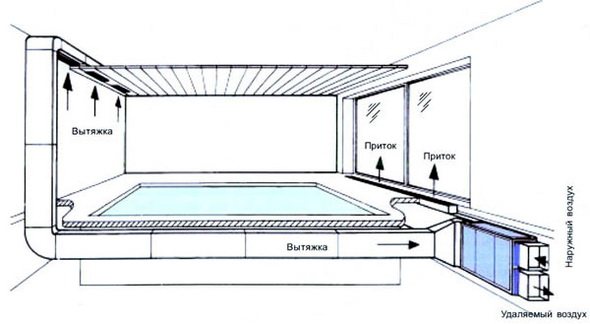
The classic version of the ventilation of the pool in a private house of a small mirror
During the construction of the pool, the project is developed individually. The main requirement is to ensure the safety and comfortable stay of people inside the premises.
In order for ventilation units for swimming pools to work effectively, it is necessary to design their installation taking into account:
- The size of the room.
- The number of people using the pool.
- The area of the water surface of the pool.
- Air and water temperature requirements.
- The rate of evaporation of water, which depends on its temperature. The warmer the water, the faster it evaporates.
Taking these parameters into account, the appropriate power supply and exhaust ventilation for the pool is selected. If the equipment is chosen incorrectly, this will lead to an imbalance between air humidity and temperature. This will contribute to the settling of condensate and create an unfavorable atmosphere for human health.
Why can't you immediately contact the installation company?
Pool ventilation is a technological system. It is NOT calculated using standard methods of air exchange rate and thus is fundamentally different from ventilation in a cottage, office or restaurant. Therefore, the decisions that installation firms will put in your estimate in 90% of cases will be incorrect.
If you already have an estimate for the installation, you can send it to me and I will tell you all their mistakes.
Firstly, In most private pools, specialized installations with recuperators and a dehumidifier are not needed. They are expensive and are used for very different purposes. Secondly, Automation, which is built into most installations, requires specification at the factory. You can't buy any rig and hang it. Such equipment will not work properly. The units must be programmed according to the humidity schedule. Thirdly, Installation firms select installations at random. And this is not a slip of the tongue on my part. To make the correct selection, they should ask you what additional equipment you plan to put into the pool and the mode of switching on this equipment. More often than not, no one asks anything. For example: For a pool with a counterflow, equipment for 1500m3 / h is required for 230,000 rubles, and for a pool without a counterflow - for 900m3 / h for 145,000 rubles. One question saves the Customer from 85,000 rubles.
Air exchange rates in the pool
Main pool standard SP 310.1325800.2017
I will consider the most important requirements:
1. It is necessary to maintain 30 ° C indoors all year roundsince people walk around naked, so the supply air temperature is calculated not at 23 ° C, as in ordinary rooms, but at 30 ° C.
2. Relative air humidity not more than 55-65%. In pools in wooden houses, the air humidity should be no more than 45%. A change in humidity by at least 5% requires a change in air volumes by 35%, therefore, humidity for calculating pool ventilation is the most important indicator.
3. Air mobility 0.2 m / s. Therefore, there are always very large ventilation grilles in the pool. The speed of the bars should be kept to a minimum so that people do not catch cold.
4. The hoods are larger than the inflow. In the halls for swimming pools, the supply air volume is 10% more than the extract air volume. This is done so that humid air does not escape into adjacent rooms.
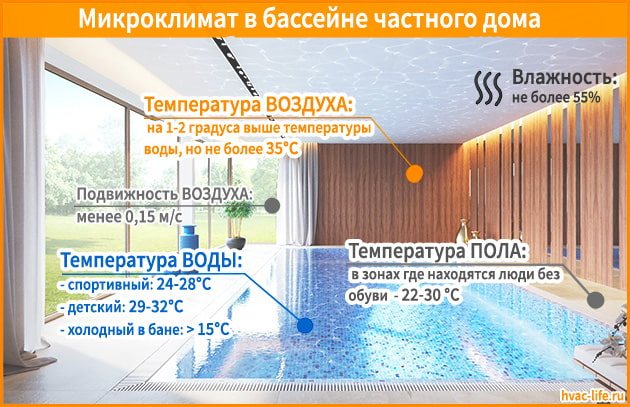

Features of air exchange
Humidity is constantly increasing due to the evaporation of water, from the surface, wet steps. This process is ongoing.The indicator increases by 10% - 20%, so the ventilation of the pool must work constantly. Covering the surface with a special film, the use of automated curtains suppresses the process, but it is difficult to achieve acceptable humidity values with a large volume of water without the use of forced air exchange.
Excessive humidity negatively affects the well-being of athletes, it is more difficult for a person to breathe, he gets tired faster, and sports results drop sharply. For casual bathers, being in a damp building does not add to their comfort.
Excess water spoils the elements of decoration, equipment of the room. In such conditions, fungus, mold and other dangerous microorganisms actively develop, and the equipment requires additional protection or frequent replacement.
Pool ventilation installed will be effective. Our engineers are ready to implement projects of any complexity, and the installation team will install all the necessary elements, launch the network within a predetermined time frame. We offer a comprehensive service from the preparation of those. tasks prior to delivery of the system to the customer. We have at our disposal the equipment of leading manufacturers, which will be installed at your facility. We work with small private buildings and large public buildings, at the stage of construction or reconstruction of facilities.
How much air is needed to ventilate the pool?
The air flow for ventilation of the pool is calculated depending on the moisture release i.e. the amount of moisture released from the water mirror.
The amount of excess moisture depends on the region of construction, the presence of a dehumidifier, the area of the bowl (area of the water surface), the coefficient of evaporation rate (Δßb). Amusement rides have a serious impact on air consumption: water slides, counterflow, massager, underwater jets, fountains and geysers.


Pool ventilation calculation
I will analyze the calculation of ventilation using the example of a pool of 23 m2
| Swimming pool 6.9x3.4m in the cottage | Ventilation capacity of the pool 23 m2 depending on conditions: | ||||
| With counterflow, underwater jets (without dryer) in Moscow | With counterflow, underwater jets (with a dryer) in Moscow | With geyser and fountain (without dehumidifier) in Moscow | With counterflow, underwater jets (without dryer) in Samara | With geyser and fountain (without dehumidifier) in Samara | |
| Inflow | 1540 m3 / h | 770 m3 / h | 1030 m3 / h | 1390 m3 / h | 940 m3 / h |
| Hood | 1710 m3 / h | 860 m3 / h | 1150 m3 / h | 1550 m3 / h | 1040 m3 / h |
| Dehumidifier | – | 117 l / day | – | ||
As you can see, the air volume for the same pool of 23 m2 for different conditions is different, so online calculators cannot take into account all indicators and count with a margin. For example, a counterflow system in a pool increases the size of ventilation equipment by 33%, and installing a water slide by 50%!
For an accurate calculation of your pool, I advise you to develop a ventilation project and do not spare 25-40 thousand rubles. For design, you will need architectural plans in DWG (AutoCAD).
Air supply from the pool floor
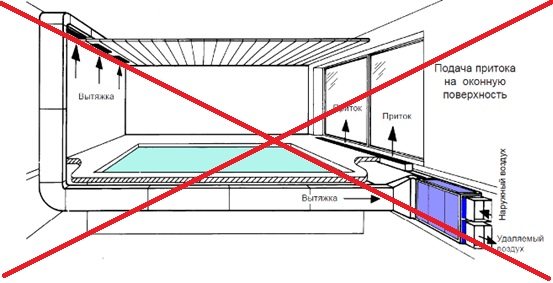

Air supply from the pool floor
There is a picture on the Internet where air is supplied to the pool from the floor, and there is a ventilation unit on the technical floor. I have to explain to my Customers that in practice it is impossible to do this:
• It is impossible to punch holes of such a size that the air speed from them would be less than 0.5 m / s, and at a higher speed there will be drafts and discomfort. on which the bowl rests. Quite problematic • In the window area there are heating convectors and piping. You will have to order custom-made convectors, which is long and expensive.
Eventually: in private pools, such a scheme is abandoned in 90% of cases.In commercial swimming pools, this type of air supply is often used, but it is envisaged at the stage of building construction, where the bowl is a separate monolith.
Ventilation types
The calculation is carried out according to several schemes using power units for the pool, which ensure the movement of air masses in the calculated volumes. Natural air exchange at such facilities is not used, since its capacity is low and insufficient in conditions of high humidity.
Forced ventilation is classified according to the set of equipment and the organization of the air flow. The choice of a certain scheme is carried out based on the characteristics of the object, its size, the number of visitors, and the area of the water surface.
- Air removal is used for small pools with limited surface dimensions. The equipment consists of one or more fans, which are installed in the upper part. During the operation of the devices, some vacuum is generated, which ensures a stable supply flow that naturally enters the room. At the sampling points, filter elements are installed to clean the air from street dust. The system can be supplemented with a drying unit.
- The air handling unit produces forced air supply. As a result, excessive pressure is formed, air currents are formed, which remove humidified air, replacing it with fresh air. At the entrance, a system of this type is equipped with filter elements to remove mechanical impurities in the outdoor air. The equipment provides high-quality circulation of the pool in the required volumes. The system is supplemented with heating elements to maintain the set flow temperature. Dehumidifiers are installed separately, since ventilation cannot completely cope with the moisture accumulated in large rooms.
Combined system
- The supply and exhaust system with heat recovery is performed as a single unit, which is equipped with air intake and air supply ducts. It can operate in full or partial recirculation mode, depending on the conditions in the pool, the characteristics of the local climate. Automation controls the main parameters, regulates the operation of the equipment. At the calculated power, ventilation will be efficient and financially beneficial. As the outside temperature drops, the recuperation system will heat the supply stream using the exhaust air. The heating system does not provide for additional elements that consume energy resources, which provides tangible savings.
- Pool ventilation with a type-setting system works on the same principles. But all power equipment is autonomous and its positioning places can be modeled according to the architectural features of the building. The elements are mounted in the most efficient places. The fan outlets are located in the lower part of the structure, and the exhaust fans are in the upper, on the opposite side. This ensures a stable air flow that dries and maintains the set temperature. Filter elements, heat exchange equipment, diffusers are installed in the discharge part, and the exhaust part is equipped only with filters. The operation of the units is controlled by sensors, and the sensors monitor the indicators of air masses, the automatic control system collects information, organizes effective work in accordance with the established algorithms.
- Ventilation system complete with dehumidifier. Such a set of units is optimal for dealing with excessive moisture. While the power equipment is circulating, the dehumidification system will condense moisture, directing it to its intended purpose.
Automation
Pool ventilation is a complex network, which provides for the presence of sensors and sensors, so it is not always possible to organize manual control. Automation significantly increases the efficiency of the system and quickly achieves optimal performance. The parameters of the state of the atmosphere can be constant or variable; this does not matter for automated control. Correction of parameters is carried out from the control panel, ventilation is adjusted to the changes made.
The use of such a system minimizes starts and increases the service life. Frequency converters and inverters reduce the maximum current loads when starting asynchronous motors, ensuring a constant voltage in the network and gentle operating conditions for powerful equipment.
Control automation functions
- Switching on / off the units according to the protocol.
- Ensuring the set parameters of air masses (temperature, humidity, flow rate). The parameters are maintained and adjusted depending on changes in external factors.
- Providing protection of power devices from overheating and emergency shutdown.
- Coordination of the work of all units.
- The alarm system warns of problems and malfunctions that have arisen.
- Modern systems provide remote control using gadgets and specialized software.
In their work, engineers use their own developments. Therefore, we offer the latest technical solutions for ventilation of premises in special conditions.
Private pool ventilation schemes
All microclimate maintenance schemes are reduced to a combination of ventilation and a dehumidifier. This is the combined dehumidification method.
There are 3 options:
• supply and exhaust units (separate); • supply and exhaust unit (single) with a bypass channel; • air handling unit (single unit) with a recuperator.
All 3 options are combined with a dehumidifier and we get 3 more schemes:
• supply and exhaust units (separate) with a dryer; • supply and exhaust unit (single) with a bypass channel and a dryer; • air handling unit (single unit) with a recuperator and a dehumidifier.
Let's figure it out, but looking ahead I'll say:
There is only one correct ventilation and dehumidification scheme for a private pool. The very first. Dehumidifiers are expensive and stupid. And recuperation and bypass are only suitable for large commercial pools.
Let's analyze each equipment in order, and everything will become clear.
Methods for organizing ventilation of pools
It is almost impossible to prevent evaporation of water from the water surface of the pool. It is possible to slightly lower the level of humidity and reduce ventilation costs by using special impermeable coatings for the water surface.
If, during operation, reduce the water temperature and increase the air temperature, then the evaporation of water from the pool will decrease.
It is also possible to prevent excessive evaporation without disturbing the supply and exhaust air flows. For the most efficient air exchange and ventilation of swimming pools, the most rational and efficient is the use of systems and equipment specially produced for the needs of artificial reservoirs.
Supply and exhaust ventilation
Good ventilation in the pool area is provided by specially designed ventilation based on air handling units with air recovery. Such a system draws in part of the air from the street and mixes it with part of the existing indoor.
After heating, the mixed air flow is delivered to the pool. By mixing the warm portion of the air in the pool with the fresh part, the energy consumption for reaching the required temperature is reduced.
With the help of the supply and exhaust circuit, the humidity is reduced to the standard and unpleasant diffusion is eliminated. Thanks to the admixture of “street” air, the proportion of suspended particles that negatively affect the respiratory canals of people and health in general is reduced.
Counterflows are never mixed in the supply and exhaust devices. Supply grilles are installed at different levels with exhaust suction.
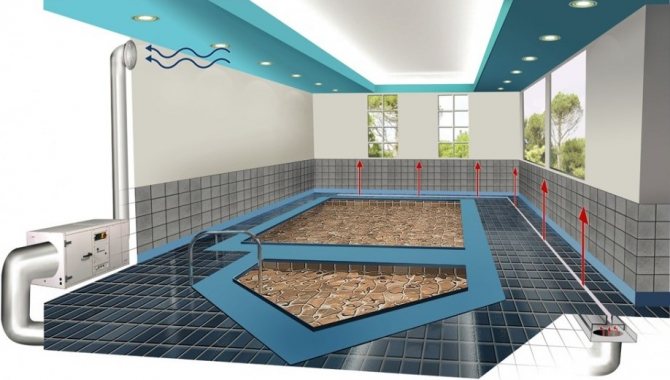

The advantages of a supply and exhaust ventilation system with a recuperator are high energy savings
Ventilation systems of this type are very effective in pools with a small surface area of the water surface and not very intensive operation. The option is economical, but does not always guarantee a comfortable level of humidity.
The principle of operation of the system is to exchange humid air from the pool for drier air from the external environment. For greater energy savings, the system is equipped with frequency controllers. With their help, the performance of the system is reduced, depending on the need for ventilation.
With the help of supply and exhaust systems, intensive air exchange is ensured throughout the year, although in the summer it is less effective due to the increased atmospheric humidity. This method is capable of dehumidifying air in 98% of cases.
The advantages are the presence of optimal parameters, the ability to adjust the capacity, a large flow of fresh air and good energy efficiency. The disadvantages include the possibility of a short-term excess of the calculated humidity in the summer.
Combination air handling unit and dehumidifier
The use of air dehumidification and the use of forced ventilation devices separately cannot guarantee the desired effect, therefore, in practice, they are combined. By combining dehumidifiers with a minimum air exchange of ventilation units, it is easy to achieve optimal humidity in the pool.
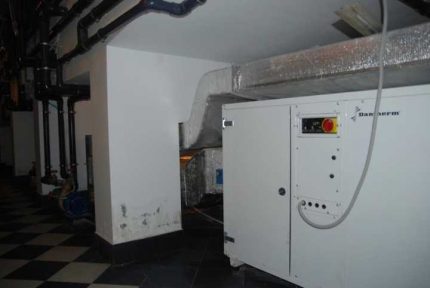

Heating, dehumidification and ventilation of the pools in the complex brings the most useful result. However, instead of separate systems assembled into a complex, it is better to install an air conditioning system that alone copes with the listed functions
Supply and exhaust ventilation devices are supplemented with wall or cassette dryers. Wall-mounted options are located in the pool area, and channel-type dehumidifiers are located in the back rooms. It is advisable to use simultaneously two dehumidification devices.
In this case, ventilation is carried out in this order: by means of a supply fan, air is supplied to the duct dehumidifier, mixed with the recirculation dehumidifier, then dehumidified and supplied to the room. Air removal takes place through an exhaust fan from the upper zone.
This forced type of air exchange with a dehumidifier is most advisable to use in private pools of cottages, in hotels or educational institutions. Duct dehumidifiers are used with a water surface of more than 50 m2.
The advantage of this method is the minimum cost, ease of installation and operation. The disadvantage is the provision of only a sanitary and hygienic norm of fresh air, a high room temperature, as well as increased electricity consumption in summer.
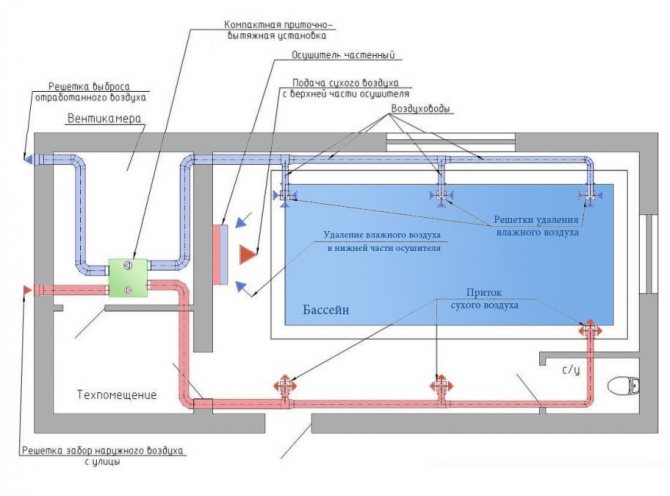

For the treatment of the pool, it is not enough to install only supply and exhaust ventilation. It only partially removes excess moisture. The system is able to show good results in tandem with air dryers (+)
The symbiosis of ventilation, dehumidifier and air conditioning systems
The most energy efficient method of reducing humidity in the pool is the installation of universal climatic systems, which are a combination of air dehumidification, ventilation and air conditioning elements.
In this case, the operation of the supply and exhaust ventilation is standard. The system is complemented by cooling sections and autonomous dryers.
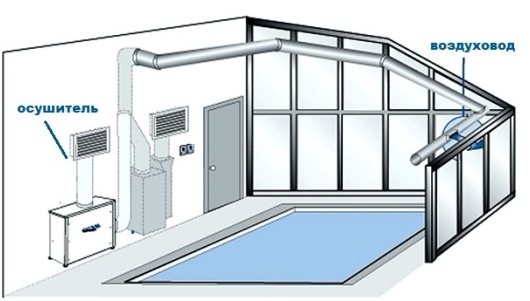

The symbiosis of an air dryer and mechanical supply and exhaust ventilation guarantees the most optimal ventilation of the pool (+)
The main load falls on the supply and exhaust ventilation. At high humidity and during peak periods, elements of dehumidification and air conditioning systems are switched on. In winter, the humidity is regulated by the dehumidifier, and the ventilation system carries out the necessary air exchange.
Today, the consumer is offered high-tech units combining all three functions, that is, ventilation, dehumidification, air conditioning. These innovative units are equipped with two-stage heat recovery units, built-in heat pump dryers and built-in automation system.
The presence of automation allows you to select the most optimal air processing mode. The advantage of the system is the availability of maximum energy efficiency and a guarantee of compliance with the required moisture parameters of the pool all year round. The complex has a high initial cost.
Recuperator for the pool. Why not needed?
A recuperator is a section in an air handling unit that saves 50% of heat for heating the supply air in winter.
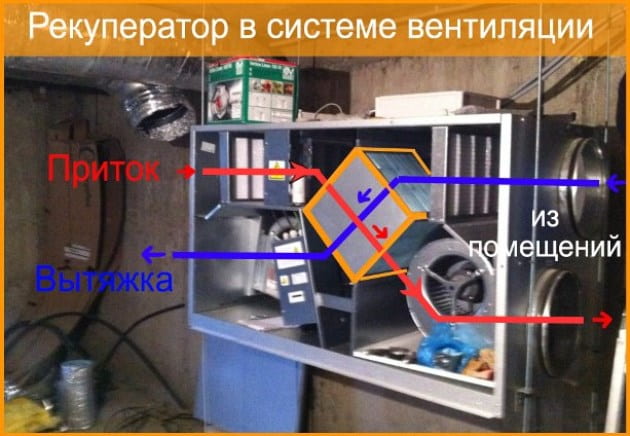

It is cold outside in winter, so you need to heat it up to supply air to the pool. It can be heated with water or electricity, but this is always an additional cost. The customer wants to save on operating costs and is doing the right thing, but the recuperator is not needed in the pools and is even harmful.
That's why:
In winter, the air outside is cold, but very dry, so very little is needed to drain the pool - 7 times less than in summer. It remains only to heat up. As a result, the volume of air for draining the pool in winter is very scanty, from 350 to 500 m3 / h, and a minimum of 1500 m3 / h is required for the payback of the recuperator.
The recuperator is needed in pools with a water surface of at least 80 m2.
In winter, the air handling unit will reduce the speed, and the air heater will operate at a minimum. It turns out that there is simply nothing to save. In the summer, the unit will increase the air supply, but the heater will not work.
With the installation of a recuperator in the pool, we get a big problem.
The recuperator in the pool is constantly freezing and condensation flows. Due to the fact that the exhaust air is humid, and the supply air from the street is very cold, the walls of the recuperator are very cooled. The humid extract air condenses on the cold walls of the recuperator i.e. moisture falls out of the air. As a result, in autumn and spring, condensate constantly flows from the installation. And when cold weather sets in, the moisture on the walls of the recuperator freezes and the equipment constantly turns on the defrost mode.
Output: The recuperator in the ventilation of the pool is simply not needed. The supply air volume in winter is too small to save heat, and the extract air is too humid, which will lead to condensation on the walls of the recuperator and subsequent freezing.
If you really want to conserve heat in your ventilation system, consider louvers to cover the water mirror outside of business hours. So you can reduce the moisture release of the pool, and therefore reduce the air volume and consumption of the ventilation system by 70%.
Swimming pool microclimate
The pool ventilation device is an extremely important factor in creating a comfortable microclimate for humans. The lack of a high-quality ventilation system leads to the rapid spread of mold and mildew, and the accumulation of a large number of microorganisms in the air leads to various diseases.
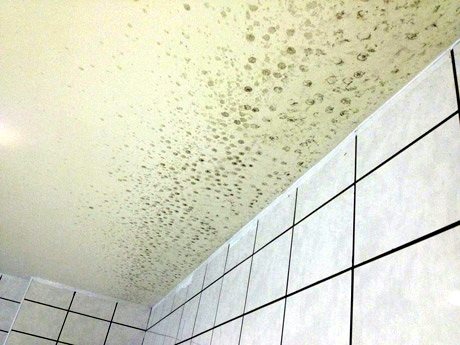

High humidity in a closed pool area leads to corrosion of metal and rotting of wooden structures, destruction of finishes and walls by fungus
The humidity in the pool room should be at the level of 50-60%, in this case, a moderate level of moisture evaporation from the water surface is achieved, which affects the comfort conditions in the room.At a given humidity and an air temperature of 28-30 ° C (typical temperature for pool rooms), dew will form at 16-21 ° C. This is noticeably higher than for ordinary rooms, in which the air temperature is at 24 ° C, humidity is 50%, and the dew point is at 13 ° C. For indoor swimming pools, the excess of the moisture content of the air is considered the norm.
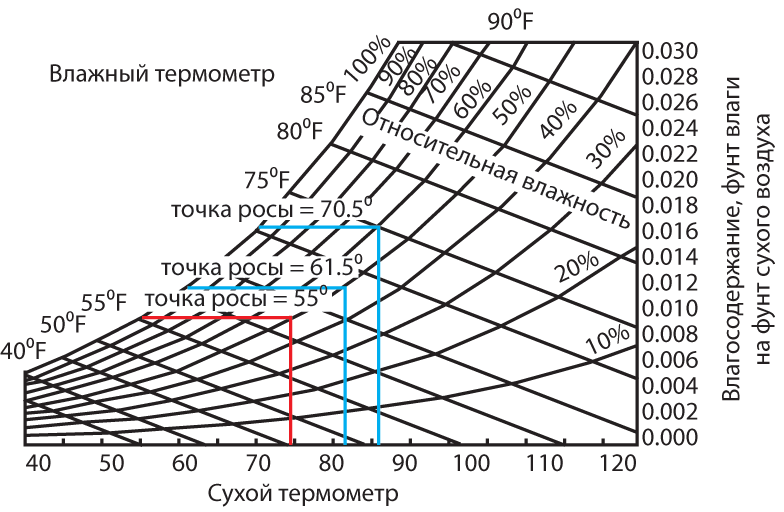

Pool air temperature and humidity
Recommended air parameters for indoor swimming pools:
- The water in the pool is within 24-28 ° С.
- The air in the pool room should be 2-3 ° C higher than the water temperature. When the air temperature drops, there is a risk of colds. When the humidity rises, a feeling of stuffiness may occur. It is also not recommended to lower the air temperature at night in order to save energy, as the heat consumption increases.
- To avoid drafts, the recommended air speed should be within the range of 0.15–0.3 m / s.
All these and many other conditions are taken into account in the design, and solutions are proposed to reduce moisture condensation on the ceiling and walls. The complexity of the situation is that when people, for example, do not use the pool at night, heat and humidity do not disappear anywhere. The pool cannot be turned off at night. The only way to reduce vaporization is to use water surface coatings, but these devices are short-lived and rarely used.
| The rate of evaporation of water from the surface of the pool, depending on the method of its operation | ||
| Pool type | Empty | With swimmers |
| Plain or skimmer pool | 10-20 grams / m² / hour | 130-270 grams / m² / hour |
When the level of 80–90% humidity is reached at a temperature of 29–30 ° C, there is a risk of exacerbation of chronic diseases, a sharp deterioration in health. Therefore, with a correctly calculated and designed ventilation scheme for a private pool, excess moisture is removed from the air, it is cleaned due to intensive air exchange, but it does not dry out.
Dehumidification of air to the required parameters is carried out by dehumidifiers, according to the parameters of moisture release. Dehumidifiers can be monoblock and built into the ventilation system (with air recovery).
An example of calculating the evaporation of water from the pool per day
Initial data:
- The size of the mirror is 4.2 × 14 m.
- indoor air temperature +28 ° C;
- pool water temperature +26 ° C;
- relative humidity 60%.
Payment:
- The surface area of the pool is 58.8 m².
- The pool is used for bathing 1.5 hours a day.
- The evaporation of water during bathing will be 270 grams / m² / hour x 58.8 m² x 1.5 hours = 23 814 grams.
- Evaporation at rest for the remaining 22.5 hours will be 20 grams / m² / h x 58.8 m² x 22.5 hours = 26,460 grams.
- Total per day: 23,814 grams + 26,460 grams / 1,000 = 50.28 kilograms of water per day.
Swimming pool ventilation unit
For swimming pools, we use conventional separate supply and exhaust units. In this case, we have the opportunity to more flexibly approach the placement of equipment. Separate units take up significantly less space than systems with a recuperator. They can be located in different rooms, for example, in the attic, in the basement and even in the suspended ceiling of the pool itself. The air handling unit, operating in 2 modes, delivers 3000 m3 / h in summer, and heats and delivers only 400 m3 / h in winter. The air extraction unit throws humid air outside, and the heating cable on the outdoor grilles protects them from icicles.
This is the simplest and most efficient ventilation scheme.To heat 400 m3 / h of air, you need only 7.5 kW of thermal energy from the boiler (not to be confused with electricity consumption) and this is at -25 ° C outside.
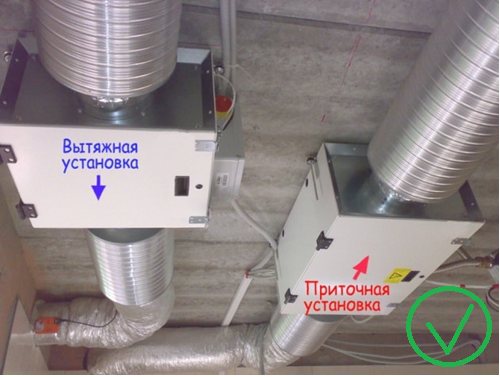

Correct ventilation system in the pool of a private house
Supplier companies will convince you to buy expensive air handling units for swimming pools, which in 90% of cases are not needed at all.As soon as you say “pool”, they have “pool installations” in their heads. And why such an attitude is needed - they cannot explain.
Svegon and Menerga companies offer equipment from 600,000 rubles. 100% of private pools do not need them, and 90% of commercial pools use 2 separate units, one with a dehumidifier and the other without.
In projects for pools in private houses, we use conventional supply and exhaust units from NED, Breezart, Systemair, Ventmachine. We design suspended, channel-type installations in a sound-insulated casing with a full set of automation.
Norms and standards: optimal microclimate of a room with a swimming pool
Each type of premises has its own standard indicators, since the required microclimate and conditions can be varied.
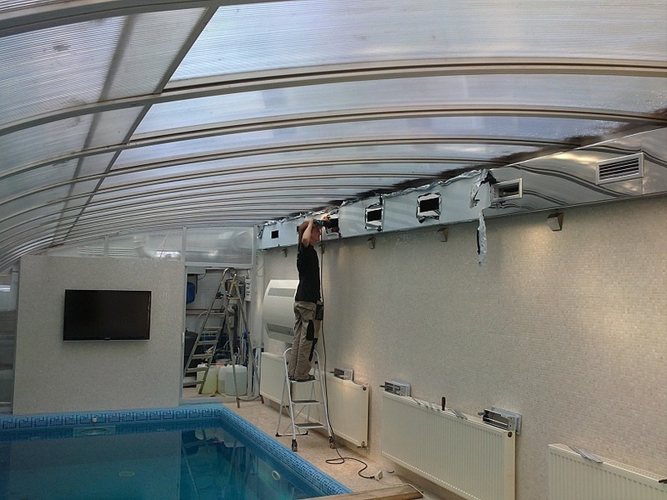

Installation of ventilation for the pool
The design of a private pool is usually not done according to a template, but with individual nuances. An individual approach is necessary, because the pools in private houses and saunas are often very different from each other. Some owners make large rooms for them, combining them with a lounge. Others set up a small room without windows, with a small pool. Still others make a huge pool, and place it in the basement. Naturally, in all these cases, the ventilation system needs its own.
The pool is usually created on the ground floor, allocating a separate room for it, or in the basement. The average water surface area (recall: we are talking about small pools) is usually about 10-30 m² with a depth of 1.5-3 meters. Paths with a width of up to three meters are organized around the water reservoir.
Without fail, the room is equipped with a heating system. The situation is somewhat more complicated with the ventilation system.
Domestic standards prescribe a temperature of 30-32 degrees in the pool itself and 31-33 degrees in the hall (the room itself). The European rules are different: there the temperature in the pool should be about 28 º, and in the hall - 2-4 º higher (but you cannot make it higher than 34 º).
It is extremely important to create and maintain the correct humidity in the room: it should not exceed 65%. One visitor should receive about 80-85 m³ of air per hour, but not less. The speed of air masses should be up to 0.2 meters per second.
The maximum noise level in the room is up to 60 decibels (this is important, since you must choose equipment that will not make more noise).
We make a calculation
Knowing the amount of moisture that penetrates the building air in one hour, you can easily calculate the volume of the supply air and, accordingly, determine the required capacity of the dehumidifier. The calculation scheme is as follows: the pressure difference must be multiplied by the coefficient of the intensity of moisture evaporation.
However, in practice, such calculations are quite complicated, and they should only be performed by designers. It is enough for an ordinary person to know the planned water temperature and air temperature in the hall, with the coefficients of their use. Further information can be found in special tables.
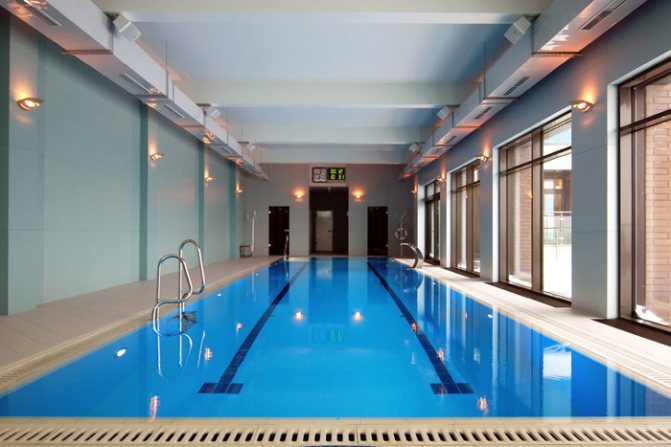

Equipped pool with ventilation system
Consider, as an example, the calculation for an indoor pool in a cottage. Such a pool will have a coefficient of 0.5-1 units, while, for example, in a water park, the coefficient will be 25-30 (due to the large number of people during the day).
It is important to remember: the more water, the more intense the evaporation. But you can not go into such a jungle, it is enough to understand that for most private pools, 200-300 g / m² is enough.
However, such a calculation is relevant only if the standard temperatures of water and air are observed, as well as the humidity is normalized. And this value, given above, should be multiplied by the area of the pool.
The amount of supply air is calculated based on the following parameters:
- how much moisture evaporates in the hall;
- how much moisture is in the air and outside;
- specific air density at a pre-planned pool temperature.
Problems can arise with the moisture reading as it changes with the season and weather conditions. Therefore, you need to take the average value, which is relevant for most cases - 9 g / kg. If you live in the southern or northern regions, then it is better to know this indicator more precisely.
Then we make a calculation: the parameter of the evaporated moisture is divided by the difference in the amount of liquid in the air and outside and multiplied by the density of the air. The result obtained should be the main guideline when selecting the capacity of installations and equipment for the ventilation system.

